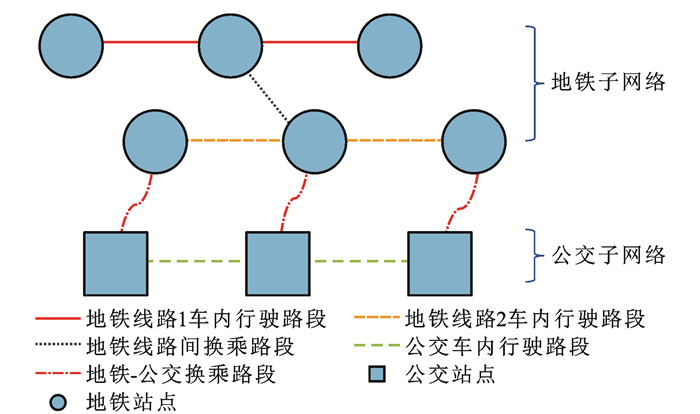Resilience-based protection decision optimization for metro network under operational incidents
-
摘要: 为缓解地铁运营事件的负面影响,提高地铁网络应对运营事件的能力,研究了地铁网络保护决策优化问题;以网络韧性为目标,考虑了网络性能降级和恢复过程中韧性曲线的变化特性和累积性能损失,构建了地铁网络保护决策的双层优化模型,上层模型为随机整数规划模型,用于获取不确定运营事件场景下待保护站点的最优选择,下层模型为用户均衡配流问题,特别考虑了容量有限站点内排队客流和乘客等待恢复时间的变化,以准确估计运营事件下乘客出行延误;基于遗传算法和Frank-Wolfe算法分别求解上层模型和下层模型;以西安市中心区域地铁网络为例,验证并分析了提出的模型和算法。分析结果表明:基于韧性的保护决策通过保护研究区域37.5%的站点,可以使网络性能损失降低超过50%,优于基于脆弱性的保护决策和不考虑公交网络替代作用的保护决策;当保护网络中1/2的地铁站点时,相比基于脆弱性的保护决策,基于韧性的保护决策的网络性能损失和客流时间损失分别降低了6.18%和582 h;公交网络的替代作用会导致地铁网络中超过2/3的站点保护优先级发生变化;同一类型的站点中,客流量越大,越依赖公交网络的替代作用;地铁站点的保护优先级主要取决于经过的客流量和运输能力,站点经过的客流量越大,运输能力越低,其保护优先级越高;站点类型也是影响保护优先级的因素,尤其对于客流量大的站点,非换乘站需要更高的保护优先级。Abstract: The protection decision optimization problem for metro networks was studied to alleviate the negative impacts triggered by operational incidents and improve the capability of metro networks to tackle these incidents. For the network resilience, the variation characteristics of the resilience curve and cumulative loss of the performance in the degradation and recovery of network performance were considered, and a two-layer optimization model for metro network protection decisions was constructed. The upper model was a stochastic integer programming model for identifying the optimal choice of the stations to be protected in the scenarios of uncertain operational incidents. The lower model was a user equilibrium assignment problem, and the variations in the queueing passenger flow and waiting time for recovery at the stations with limited capacity were prioritized to accurately estimate the delay time for passenger travel under operational incidents. The genetic algorithm and Frank-Wolfe algorithm were used to solve the upper and lower models, respectively. The metro network in the central area of Xi'an was taken as an example to verify and analyze the proposed models and algorithms. Analysis results show that the resilience-based protection decision is capable of reducing the loss of network performance by more than 50% by protecting 37.5% of the stations in the research region. It is superior to the vulnerability-based protection decision and the one without considering the substitution role of the bus network. Compared to the situation of the vulnerability-based one, the losses of network performance and passenger flow time reduce by 6.18% and 582 h, respectively, when half of the metro stations in the network are protected by the resilience-based protection decision. The protection priorities of more than two-thirds of stations in the metro network alter due to the substitution role of the bus network. For the same type of stations, their dependence on the substitution role of the bus network enhances with the increase in the passenger flow. The protection priority of a metro station is dependent mainly on the passing passenger flow and transportation capacity. A larger passenger flow is accompanied by a lower transportation capacity and higher protection priority of corresponding stations. The station type is also a factor determining the protection priority, especially for the stations with large passenger flows, and higher protection priorities are required for the non-transfer stations.
-
表 1 地铁站点参数
Table 1. Metro station parameters
编号 站点名称 车头时距/min 地铁列车容量/(人次·veh-1) 正常运营路段客流/(人次·h-1) 1 西北工业大学(5号线) 4 560 2 232 2 边家村 4 460 2 127 3 省人民医院·黄雁村 4 460 2 505 4 南稍门(5号线) 4 380 2 949 5 文艺路 4 440 1 428 6 建筑科技大学·李家村(5号线) 4 540 2 547 7 太乙路 4 560 1 242 8 雁翔路北口 4 560 1 482 9 青龙寺(5号线) 4 480 1 389 10 青龙寺(3号线) 3 480 1 563 11 北池头 3 480 1 299 12 大雁塔(3号线) 3 320 3 852 13 小寨(3号线) 3 380 3 624 14 吉祥村 3 480 2 568 15 太白南路 3 480 2 103 16 科技路(3号线) 3 560 2 985 17 科技路(6号线) 4 560 2 307 18 西北工业大学(6号线) 4 560 2 307 19 南稍门(2号线) 2 360 2 565 20 建筑科技大学·李家村(4号线) 4 400 2 343 21 体育场 2 400 1 629 22 西安科技大学 4 400 1 341 23 小寨(2号线) 2 340 2 820 24 大雁塔(4号线) 4 280 2 682 表 2 不同保护预算水平下的最优保护决策
Table 2. Optimal protection decisions under different protection budget levels
预算/个 韧性 保护决策站点选择 0 2.72 无 3 2.09 12、14、15 6 1.61 4、12、13、14、15、16 9 1.25 2、3、4、12、13、14、15、16、21 12 0.91 2、3、4、6、12、13、14、15、16、19、21、24 15 0.62 2、3、4、6、12、13、14、15、16、17、18、19、21、22、24 18 0.38 2、3、4、6、8、10、12、13、14、15、16、17、18、19、21、22、23、24 21 0.17 1、2、3、4、6、7、8、10、12、13、14、15、16、17、18、19、20、21、22、23、24 -
[1] LU Qing-chang. Modeling network resilience of rail transit under operational incidents[J]. Transportation Research Part A: Policy and Practice, 2018, 117: 227-237. doi: 10.1016/j.tra.2018.08.015 [2] LIU Kai, ZHU Jia-tong, WANG Ming. An event-based probabilistic model of disruption risk to urban metro networks[J]. Transportation Research Part A: Policy and Practice, 2021, 147: 93-105. doi: 10.1016/j.tra.2021.03.010 [3] ZHANG Shu-yang, LO H K, NG K F, et al. Metro system disruption management and substitute bus service: a systematic review and future directions[J]. Transport Reviews, 2021, 41(2): 230-251. doi: 10.1080/01441647.2020.1834468 [4] 马超群, 张爽, 陈权, 等. 客流特征视角下的轨道交通网络特征及其脆弱性[J]. 交通运输工程学报, 2020, 20(5): 208-216. doi: 10.19818/j.cnki.1671-1637.2020.05.017MA Chao-qun, ZHANG Shuang, CHEN Quan, et al. Characteristics and vulnerability of rail transit network based on perspective of passenger flow characteristics[J]. Journal of Traffic and Transportation Engineering, 2020, 20(5): 208-216. (in Chinese) doi: 10.19818/j.cnki.1671-1637.2020.05.017 [5] LU Qing-chang, ZHANG Lei, XU Peng-cheng, et al. Modeling network vulnerability of urban rail transit under cascading failures: a coupled map lattices approach[J]. Reliability Engineering and System Safety, 2022, 221: 108320. doi: 10.1016/j.ress.2022.108320 [6] YAN Yong-ze, HONG Liu, HE Xiao-zheng, et al. Pre-disaster investment decisions for strengthening the Chinese railway system under earthquakes[J]. Transportation Research Part E: Logistics and Transportation Review, 2017, 105: 39-59. doi: 10.1016/j.tre.2017.07.001 [7] 陈学伟, 秦进, 周颖靓. 不确定环境下交通网络应急预防护优化研究[J]. 铁道科学与工程学报, 2021, 18(5): 1307-1315. doi: 10.19713/j.cnki.43-1423/u.T20200623CHEN Xue-wei, QIN Jin, ZHOU Ying-liang. Optimization of transportation network emergency prevention in uncertain environments[J]. Journal of Railway Science and Engineering, 2021, 18(5): 1307-1315. (in Chinese) doi: 10.19713/j.cnki.43-1423/u.T20200623 [8] JIN Jian-gang, LU Lin-jun, SUN Li-jun, et al. Optimal allocation of protective resources in urban rail transit networks against intentional attacks[J]. Transportation Research Part E: Logistics and Transportation Review, 2015, 84: 73-87. doi: 10.1016/j.tre.2015.10.008 [9] STARITA S, SCAPARRA M P. Optimizing dynamic investment decisions for railway systems protection[J]. European Journal of Operational Research, 2016, 248(2): 543-557. doi: 10.1016/j.ejor.2015.07.025 [10] STARITA S, SCAPARRA M P. Passenger railway network protection: a model with variable post-disruption demand service[J]. Journal of the Operational Research Society, 2017, 64(4): 603-618. [11] SARHADI H, TULETT D M, VERMA M. An analytical approach to the protection planning of a rail intermodal terminal network[J]. European Journal of Operational Research, 2017, 257(2): 511-525. doi: 10.1016/j.ejor.2016.07.036 [12] 宋鸿宇, 上官伟, 盛昭, 等. 基于弹复力调整的高速列车群动态运行轨迹优化方法[J]. 交通运输工程学报, 2021, 21(4): 235-250. doi: 10.19818/j.cnki.1671-1637.2021.04.018SONG Hong-yu, SHANGGUAN Wei, SHENG Zhao, et al. Optimization method of dynamic trajectory for high-speed train group based on resilience adjustment[J]. Journal of Traffic and Transportation Engineering, 2020, 21(4): 235-250. (in Chinese) doi: 10.19818/j.cnki.1671-1637.2021.04.018 [13] 李兆隆, 金淳, 胡畔, 等. 基于弹复性的交通网络应急恢复阶段策略优化[J]. 系统工程理论与实践, 2019, 39(11): 2828-2841. https://www.cnki.com.cn/Article/CJFDTOTAL-XTLL201911010.htmLI Zhao-long, JIN Chun, HU Pan, et al. Resilience-based recovery strategy optimization in emergency recovery phase for transportation networks[J]. Systems Engineering—Theory and Practice, 2019, 39(11): 2828-2841. (in Chinese) https://www.cnki.com.cn/Article/CJFDTOTAL-XTLL201911010.htm [14] BEŠINOVIĆ N. Resilience in railway transport systems: a literature review and research agenda[J]. Transport Reviews, 2020, 40(4): 457-478. doi: 10.1080/01441647.2020.1728419 [15] ZHANG Dong-ming, DU Fei, HUANG Hong-wei, et al. Resiliency assessment of urban rail transit networks: Shanghai Metro as an example[J]. Safety Science, 2018, 106: 230-243. doi: 10.1016/j.ssci.2018.03.023 [16] 张洁斐, 任刚, 马景峰, 等. 基于韧性评估的地铁网络修复时序决策方法[J]. 交通运输系统工程与信息, 2020, 20(4): 14-20. https://www.cnki.com.cn/Article/CJFDTOTAL-YSXT202004003.htmZHANG Jie-fei, REN Gang, MA Jing-feng, et al. Decision-making method of repair sequence for metro network based on resilience evaluation[J]. Journal of Transportation Systems Engineering and Information Technology, 2020, 20(4): 14-20. (in Chinese) https://www.cnki.com.cn/Article/CJFDTOTAL-YSXT202004003.htm [17] 殷勇, 陈锦渠, 朱蔓, 等. 城市轨道交通站点失效修复策略[J]. 西南交通大学学报, 2020, 55(4): 865-872. https://www.cnki.com.cn/Article/CJFDTOTAL-XNJT202004024.htmYIN Yong, CHEN Jin-qu, ZHU Man, et al. Repair strategies for failure of urban rail transit stations[J]. Journal of Southwest Jiaotong University, 2020, 55(4): 865-872. (in Chinese) https://www.cnki.com.cn/Article/CJFDTOTAL-XNJT202004024.htm [18] 黄莺, 刘梦茹, 魏晋果, 等. 基于韧性曲线的城市地铁网络恢复策略研究[J]. 灾害学, 2021, 36(1): 32-36. https://www.cnki.com.cn/Article/CJFDTOTAL-ZHXU202101007.htmHUANG Ying, LIU Meng-ru, WEI Jin-guo, et al. Research on urban metro network recovery strategy based on resilience curve[J]. Journal of Catastrophology, 2021, 36(1): 32-36. (in Chinese) https://www.cnki.com.cn/Article/CJFDTOTAL-ZHXU202101007.htm [19] 吕彪, 管心怡, 高自强. 地铁网络服务韧性评估与最优恢复策略[J]. 交通运输系统工程与信息, 2021, 21(5): 198-205, 221. https://www.cnki.com.cn/Article/CJFDTOTAL-YSXT202105021.htmLYU Biao, GUAN Xin-yi, GAO Zi-qiang. Evaluation and optimal recovery strategy of metro network service resilience[J]. Journal of Transportation Systems Engineering and Information Technology, 2021, 21(5): 198-205, 221. (in Chinese) https://www.cnki.com.cn/Article/CJFDTOTAL-YSXT202105021.htm [20] 陈锦渠, 张帆, 彭其渊, 等. 大客流下城市轨道交通站点韧性评估及划分[J]. 安全与环境学报, 2022, 22(6): 2994-3002. https://www.cnki.com.cn/Article/CJFDTOTAL-AQHJ202206008.htmCHEN Jin-qu, ZHANG Fan, PENG Qi-yuan, et al. Resilience assessment and partition of an urban rail transit station under large passenger flow[J]. Journal of Safety and Environment, 2022, 22(6): 2994-3002. (in Chinese) https://www.cnki.com.cn/Article/CJFDTOTAL-AQHJ202206008.htm [21] WANG J Y T, EHRGOTT M, CHEN A. A bi-objective user equilibrium model of travel time reliability in a road network[J]. Transportation Research Part B: Methodological, 2014, 66: 4-15. [22] CAI Hong, ZHU Jin-fu, YANG Cheng, et al. Vulnerability analysis of metro network incorporating flow impact and capacity constraint after a disaster[J]. Journal of Urban Planning and Development, 2017, 143(2): 04016031. [23] CHEN Jin-qu, LIU Jie, PENG Qi-yuan, et al. Resilience assessment of an urban rail transit network: a case study of Chengdu Subway[J]. Physica A: Statistical Mechanics and Its Applications, 2022, 586: 126517. [24] NOGAL M, O'CONNOR A, CAULFIELD B, et al. Resilience of traffic networks: from perturbation to recovery via a dynamic restricted equilibrium model[J]. Reliability Engineering and System Safety, 2016, 156: 84-96. [25] 侯本伟, 李小军, 韩强, 等. 基于Monte Carlo模拟的公路网络震后连通性与通行时间分析[J]. 中国公路学报, 2017, 30(6): 287-296. https://www.cnki.com.cn/Article/CJFDTOTAL-ZGGL201706012.htmHOU Ben-wei, LI Xiao-jun, HAN Qiang, et al. Post-earthquake connectivity and travel time analysis of highway networks based on Monte Carlo simulation[J]. China Journal of Highway and Transport, 2017, 30(6): 287-296. (in Chinese) https://www.cnki.com.cn/Article/CJFDTOTAL-ZGGL201706012.htm [26] AYDIN N Y, DUZGUN H S, HEINIMANN H R, et al. Framework for improving the resilience and recovery of transportation networks under geohazard risks[J]. International Journal of Disaster Risk Reduction, 2018, 31: 832-843. [27] 李淑庆, 李哲, 朱文英. 一体化公交网络均衡配流模型[J]. 交通运输工程学报, 2013, 13(1): 62-69. doi: 10.19818/j.cnki.1671-1637.2013.01.010LI Shu-qing, LI Zhe, ZHU Wen-ying. Equilibrium assignment model of integrated transit network[J]. Journal of Traffic and Transportation Engineering, 2013, 13(1): 62-69. (in Chinese) doi: 10.19818/j.cnki.1671-1637.2013.01.010 [28] KATO H, KANEKO Y, INOUE M. Comparative analysis of transit assignment: evidence from urban railway system in the Tokyo Metropolitan Area[J]. Transportation, 2010, 37: 775-799. [29] JUN M J, CHOI K, JEONG J E, et al. Land use characteristics of subway catchment areas and their influence on subway ridership in Seoul[J]. Journal of Transport Geography, 2015, 48: 30-40. [30] GORDON J B, KOUTSOPOULOS H N, WILSON N H M. Estimation of population origin-interchange-destination flows on multimodal transit networks[J]. Transportation Research Part C: Emerging Technologies, 2018, 90: 350-365. -





 下载:
下载:









